 |
  Home | Contact | Site Map |

| Top Destinations |
|
You are here Home » Top Destinations » Jaipur Rajasthan
Honeymoon in Jaipur, Rajasthan, India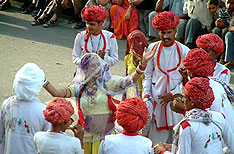 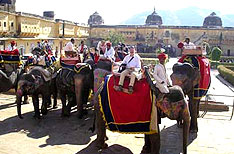 About Jaipur The picturesque capital of Rajasthan, Jaipur is also known as the Pink city. The color pink is associated with culture. There is a timeless appeal in the colorful bazaars of Jaipur, where one can shop for Rajasthani handlooms and trinkets. Beautifully laid out gardens and parks, attractive monuments and marvelous heritage hotels, which were once the residence of Maharajas, are worthy of admiration. Not to mention the ambling camels and cheerful people in multi-hued costumes, that makes your trip to the pink city a memorable one. HISTORYBuilt in 1727 A. D. by Maharaja Sawai Jai Singh II, Jaipur displays a remarkable harmony and architectural splendor. The ancient heart of the pink city still beats in its fairy-tale palaces; rugged fortresses perched on barren hills and broad avenues, which dot the entire city. The only planned city of its time, a formidable wall encircles Jaipur. A young Bengali architect, Vidyadhar Bhattacharya, formalized the plans of the city, in a grid system. The wide straight avenues, roads, streets, lanes and uniform rows of shops on either side of the main bazaars, were arranged in nine rectangular city sectors (Chokris), in accordance with the principles of town planning set down in the Shilpa Shastra - an epochal treatise on the Hindu architecture. CULTUREHospitality is the main feature of the cultural specialties here. The city is also known for its colorful atmosphere, associated with well being and cheer. SHOPPINGJaipur is famous for its lacquer jewelry, painted with enamel, encrusted with kundan, sell lacquer jewelry. Precious and semi-precious stones including garnets, emeralds, rubies, topaz and amethyst are also very popular with tourists. Tie-and-dye work on silk and crepe and the Sanganer block prints are the specialties of Jaipur. Large and small units of block and screen printers at Sanganer village produce some of the finest hand-printed textiles. You can purchase Sanganer bed linen, table linen and dress material on a variety of fabrics in the village or at any outlet in the Pink City. Ethnic block prints can also be bought at Anokhi. Crafts Impression, 17 Civil Lines offers traditional crafts of Rajasthan. Khadi Ghar and Rajasthali are places where you should definitely have a browse. While in Sanganer, dont forget to check out Jaipur blue pottery. The thumb rule for bargaining at roadside stalls still operates here. So you can make some good buys. The Jaipuri razai is also very popular. FOODPanghat packs dinner and traditional entertainment together, in a cocktails and Tandoori fare at the Taj Rambaghs amphitheater. Suvarna, also at Rambagh, is a multi-cuisine restaurant. Lakshmi Misthaan Bhandaar, popularly known as LMB, gives you Rajasthan on a plate including their renowned ghewar. Copper Chimney (multi-cuisine - close to GPO) offers a deal of Rs 200-Rs 250 per person for any course (vegetarian or non-vegetarian). Pizza Hut is at the Ganapati Plaza (Tel: 388 627 for free home delivery) For a taste of real Rajasthan, complete with heat and dust, drive out to Tonk Road. Choki Dhani (22 km out of the city). Dont expect to find tables and settle down to a traditional vegetarian meal, laced with desi ghee. While there you can also watch folk performances or go on a camel ride (recommended before lunch or dinner!). ENTERTAINMENTThe Gangaur fair, dedicated to the Goddess Gauri, is celebrated in the months of April and March. Theres a lot of singing, dancing and processions with colourful costumes. The Elephant Festival during March is awesome with its games of elephant polo and tug-of-war sessions between the animals and men. The Teej Fair in July-August is the festival of swings, celebrated during the monsoons. Makar Sankranti, celebrated on the 14th of January, is the kite-flying festival. General Information of Jaipur LOCATIONEnveloped by the craggy Aravalli range in a peninsular fashion, Jaipur is situated in the heart of the Thar Desert in northwest India, 262-km southwest of Delhi. How to Reach By AirJaipur is well connected to all major cities in India by air. IA and Jet Airways have daily flights from Delhi and Mumbai. IA also flies in thrice a week from Calcutta. Sahara has daily flights from Mumbai. Airport: The Sanganer Airport is 12 km out of the city. Taxis and autorickshaws are available for Rs 150-300. By RailThe Shatabdi Express and Pink City Express come in from Delhi. Trains also come in from Calcutta and Mumbai. Railway station: The railway station is in the heart of the city. Taxis and rickshaws are available. By RoadLinked by the National Highways 8 and 11, Jaipur is a fairly smooth drive from Agra (230 km) and Delhi (258 km). The route is dotted with tiny villages and refreshment points. Behror (130 km from Delhi) and Dharuhera (75 km) are well equipped with fast food joints, motor repair centres and motels on the Agra-Delhi-Jaipur route. Deluxe coaches operated by RTDC, ITDC and others run from Delhi, Agra, Udaipur and Jodhpur. Taxi service is available from all destinations at negotiable prices. Buses shuttle between Delhi and Jaipur almost every hour from Bikaner House at Delhi. The last bus leaves at 12 midnight. Bus terminus: The Sindhi Camp Bus Stand provides round-the-clock service for intercity road travel. The main bus stand on Station Road offers luggage storage space for Rs 5 per baggage for half a day. Buses also pick up people from around the Narain Singh Circle. Deluxe coaches should be booked in advance at the RRSTC (Rajasthan Road State Transport Corporation) office. CLIMATEJaipur has moderate to very hot climate throughout the year. Tourist Attractions in Jaipur The City Palace 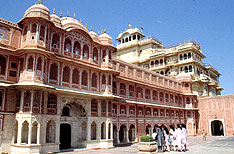 In the heart of the old city, is the former royal residence, built in a blend of the Rajasthani and Mughal styles. Grey-white marble columns, ornate with floral motifs in gold and coloured stones, support the carved arches. Two carved elephants in marble guard the entrance. The retainers whose families have served generations of rulers serve as guides. The Palace houses a museum with a superb collection of Rajasthani costumes and armory, of Mughals and Rajputs, including swords, of different shapes and sizes with chased handles, some of them inlaid with enamel and embellished with jewels, and encased in magnificent scabbards. The palace also has an art gallery, with an excellent collection of miniature paintings, carpets, royal paraphernalia and rare astronomical works, in Arabic, Persian, Latin and Sanskrit, acquired by Sawai Jai Singh II, to study astronomy in detail. The palace is within city limits and accessible by road. Sanganer At a distance of 12 km away from Jaipur city, Sanganer is located on the Tonk road. In addition to its ruined palaces, Sanganer has exquisitely carved Jain temples. The town is entered though the ruins of two tripolias (Triple gateways). The town is an important center for the crafts industry and produces some of the finest hand printed textiles, from units of block and screen printers. This textile is popular all over the country and abroad. It is well connected by roads from Jaipur, apart from other cities. Amer Amer or Amber was the former capital of the Kachhwaha Rajputs, of the old state of Dhundhar, for seven centuries. In the high season, this is one of India's most popular tourist sites, with continues a train of colorfully decorated elephants, walking up and down the ramp. From the side of the main road, one can catch a dramatic view of the hilltop palace. The Palace and the Jaigarh fort show distinct Mughal influence. Amer Palace
Ramgarh Lake It is located at 32 km northeast of Jaipur. A huge artificial lake was created, by constructing a high bund amidst tree covered hills. While the temple of Jamwa Mata and the ruins of the old fort, are some of its antiquities, its beautiful landscape, especially during monsoons, makes it an idyllic picnic spot. BM Birla Planetarium The Planetarium offers unique audio-visual education and entertainment, with its modern computerized projection system. For school groups, concessions are available. It is closed on the last Wednesday of every month. Hawa Mahal
Galtaji This is one of the ancient pilgrimage center lying beyond the gardens, amidst low hills, temples. Pavilions and holy kunds (natural spring and reservoirs) along with lush landscape make it a delightful spot. The small temple of the Sun God, built by Diwan Kriparam, on the top of the highest peak is visible from all parts of the city. Albert Hall Museum Sawai Ram Singh II built it in 1868 A.D. as a famine relief project and it includes a lush spacious garden with a zoo, an aviary, a greenhouse, a herbarlum, a museum and a popular sports ground. The Albert Hall, a fine example of Indo-Sarcenic style of architecture, designed by Sir Swinton Jacob, was opened later with an exquisite collection of sculptures, paintings, decorative wares, natural history specimen, an Egyptian mummy and the celebrated Persian carpet. Recently, the Rabindranath Manch, with an auditorium, a modern art gallery and an open-air theatre, has been added to promote cultural events. Govind Devji Temple
Samode It is a 40 km away from northwest of Jaipur. The beautiful Samode Palace, has been rebuilt and renovated and provides a fine example of the Rajput haveli architecture and is an ideal spot for outgoings. Sisodia Rani Garden Beautifully landscaped gardens, laid out in the 18th and 19th century, by kings and courtiers, dot the narrow gorge in the southeastern corner of the walled city, along the road to Agra. Sisodia Rani Garden has tiered multilevel gardens with fountains, water channel and painted pavilions and suites of living rooms. Amongst others, Vidyadhar-ka-Bagh, is the best preserved one, with shady trees, flowing water, and an open pavilion. The planner of the city, Vidyadhar, built it. Jantar Mantar
Others DOLLS MUSEUM - Pretty dolls, from various countries, are on display, in the compound of the school for deaf and dumb children, near the Police Memorial. (Time: 1200 hrs to 1900 hrs) JAIGARH - One of the few military structures of medieval India, retaining its ancient splendor in palaces, gardens, reservoirs, a granary, an armory, a well planned cannon foundry, several temples, a tall tower and a giant mounted cannon. JAIN TEMPLE - The exquisite Jain temple, on the Agra road, has some of the most beautiful 19th century paintings, in Jaipur style, on its walls. Being on the Agra road, the temple is easily accessible. MOTI DOONGRI AND LAKSHMI NARAYAN TEMPLE - Moti Doongri, is a privately owned hilltop fort, built like a Scottish castle. The Ganesh Temple at the foot of the hill and the marvelous Lakshmi Narayan Temple, built in marble, a few years back, are also noteworthy. OLD CITY - Once a settlement of nobles, craftsmen and common folks, the city of Amer is now in ruins. The remnants of its rich past are the beautifully carved and planned Jagar Shiromani Temple, a Krishna temple, associated with Meerabai, and an ancient temple of Narsing. STATUE CIRCLE - The full-length exquisitely carved statue, of Sawai Jai Singh in white marble, in the center of the circle, was erected under the newly planned scheme area, to pay homage to the founder of Jaipur. SWARGASULI (ISAR LAT)- The highest tower dominating the skyline on the western side of the Tripolia Bazaar. Sawai Ishwari Singh built it in 1749 A.D. to commemorate a grand victory. Other Excursions JAISINGHPURA KHOR - 12 km off Amer Road. One of the settlements of the Meena tribe, it has a formidable fort, a Jain temple and a steep well, amid lush surroundings. MADOGARH-TUNGA - At a distance of 40 km, on the Bassi-Lalsot Agra Road, Tunga was witness to a historic battle, fought between the Jaipur forces and the Marathas. The fort is nestled amidst beautiful mango orchards. |
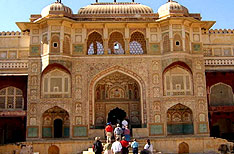 A beautiful complex of palaces, halls, pavilions, gardens and temples built by Raja Man Singh, over a period of about two centuries, still stand in a magnificent state. The palace complex emerges dramatically from the placid waters of the Maotha Lake and is approachable only through a steep path. Tourists often ride on the elephant back to the Singh Pol and the Jaleb Chowk. Two flights of stairs rise from one end of the chowk, one leading to the Shila Mata Temple and other to the palace complex. The image of the patron goddess was brought from Jessore in East Bengal (now in Bangladesh) by Raja Man Singh; to be installed here and worshipped by thousands of devotee, a spectacular pillared hall-- Diwan-e-Aam and a double storeyed painted gateway, Ganesh Pole, dominate the front courtyard. An elegant tiny garden in Charbag style, beyond the corridors, has Sukh Niwas to its right and Jas Mandir to its left. The latter combines the Mughal and Rajput architecture, seen in its beautiful interior with intricately carved Jali screens, delicate mirror and stuccowork and painted and carved dadoes. The well proportioned Mohan Bari or Kesar Kyari in the center of the Maotha Lake and the Dilaram Bagh at its north end provides a spectacular view of the palaces above.
A beautiful complex of palaces, halls, pavilions, gardens and temples built by Raja Man Singh, over a period of about two centuries, still stand in a magnificent state. The palace complex emerges dramatically from the placid waters of the Maotha Lake and is approachable only through a steep path. Tourists often ride on the elephant back to the Singh Pol and the Jaleb Chowk. Two flights of stairs rise from one end of the chowk, one leading to the Shila Mata Temple and other to the palace complex. The image of the patron goddess was brought from Jessore in East Bengal (now in Bangladesh) by Raja Man Singh; to be installed here and worshipped by thousands of devotee, a spectacular pillared hall-- Diwan-e-Aam and a double storeyed painted gateway, Ganesh Pole, dominate the front courtyard. An elegant tiny garden in Charbag style, beyond the corridors, has Sukh Niwas to its right and Jas Mandir to its left. The latter combines the Mughal and Rajput architecture, seen in its beautiful interior with intricately carved Jali screens, delicate mirror and stuccowork and painted and carved dadoes. The well proportioned Mohan Bari or Kesar Kyari in the center of the Maotha Lake and the Dilaram Bagh at its north end provides a spectacular view of the palaces above.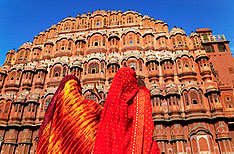 Built in 1799 A.D. the Hawa Mahal or Palace of winds is a major Rajput landmark. This five-storey building, along the main street of the old city, is in pink splendor, with semi octagonal and delicately honey combed sandstone windows. The monument was originally conceived, with the aim of enabling ladies of the royal household, to watch the everyday life and royal processions of the city.
Built in 1799 A.D. the Hawa Mahal or Palace of winds is a major Rajput landmark. This five-storey building, along the main street of the old city, is in pink splendor, with semi octagonal and delicately honey combed sandstone windows. The monument was originally conceived, with the aim of enabling ladies of the royal household, to watch the everyday life and royal processions of the city.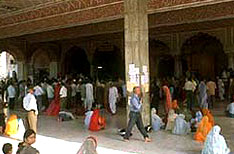 This is the most popular spire less temple of Jaipur, and is dedicated to Lord Krishna. It is located in the central pavilion of the Jai Niwas Garden to the north of Chandra Mahal. Sawai Jai Singh as his family deity reinstalled the image of the patron Deity-Govind Devji, originally installed in a temple at Vrindavan.
This is the most popular spire less temple of Jaipur, and is dedicated to Lord Krishna. It is located in the central pavilion of the Jai Niwas Garden to the north of Chandra Mahal. Sawai Jai Singh as his family deity reinstalled the image of the patron Deity-Govind Devji, originally installed in a temple at Vrindavan.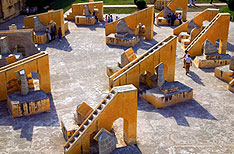 This stone observatory is the largest of Jai Singh's five remarkable observatories. Its complex instruments, whose settings and shapes are scientifically designed, represent the high points of medieval Indian astronomy. The most striking of these are the Ram Yantras used for gauging altitudes.
This stone observatory is the largest of Jai Singh's five remarkable observatories. Its complex instruments, whose settings and shapes are scientifically designed, represent the high points of medieval Indian astronomy. The most striking of these are the Ram Yantras used for gauging altitudes.